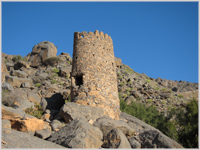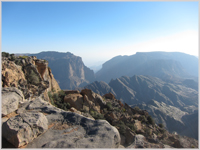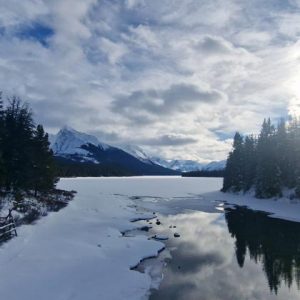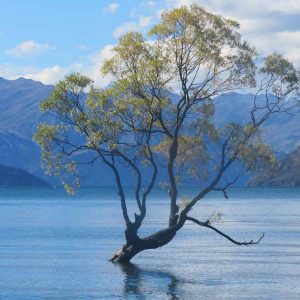In a landscape so seemingly arid, the sound of running water gives intense pleasure. The falaj, or irrigation channel, which runs through the Omani mountain village of Misfat Al Abriyeen was constructed to keep its terraces producing dates and other fruit and, coincidentally, to provide vigorous natural showers – separate for men and women. But as I lay awake it's easy to imagine there was another purpose, as a sort of mood music for romance.
Such meandering thoughts did not keep me awake for long. I had spent an exhausting day hiking up Wadi Muaydin, clambering over rocks and trying to avoid snagging my skin on the unforgiving shrub known in English as Christ's Thorn. With an Austrian guide, Jakob Oberhauser, we had started near the town of Nizwa and finished at Masirat Ruwaijhi, where villagers had laid out brightly woven rugs to air on the rocks.
As we set off Jakob told me of campers who had been foolish enough to imagine there would never be water in the wadi, and who had been swept away by a sudden flood. The ground might look bone dry but don't be fooled, he said. There was water running only a few centimetres below the surface. Swelled by rain it could well up and become a frothing torrent. Not far from the start or our hike I saw evidence in the shape of an automatic alert system, installed to warn people below when the water level had risen to danger point.
Further up the residue of one of the region's occasional storms spilled over boulders and collected in pools. Sometimes, to avoid wet boots, we were forced into a little scrambling, searching for toe and hand holds on low rock faces. At other times we simply heaved improvised stepping stones into the water.
 The patterns and colours of the rock were intriguing, here inviting comparison with a Cubist collage, there white and dark of chocolate or the wavy stripes of a Roman mosaic. Streaks of gleaming white calcite coursed through old grey limestone. In some places the track was just loose rubble while in others there remained wonderfully preserved paving stones, polished by the feet and hooves of caravans, whose participants had traded inland produce for dried fish on the coast of the Arabian Sea. On either side great rust coloured walls rose 1000 feet or more to jagged summits.
The patterns and colours of the rock were intriguing, here inviting comparison with a Cubist collage, there white and dark of chocolate or the wavy stripes of a Roman mosaic. Streaks of gleaming white calcite coursed through old grey limestone. In some places the track was just loose rubble while in others there remained wonderfully preserved paving stones, polished by the feet and hooves of caravans, whose participants had traded inland produce for dried fish on the coast of the Arabian Sea. On either side great rust coloured walls rose 1000 feet or more to jagged summits.
At the top of the wadi our support vehicle was waiting. En route to our night stop we paused to take in the astonishing view from Diana's Point on the Jebel Akhdar plateau. The Princess came during her international land mine campaign. Many mines were laid in the surrounding wadis during in the 1950s by rebels fighting the forces of Oman's Sultan, who eventually took this stronghold after a daring assault by supporting units of Britain's SAS. Away to our right loomed the twin peaks of Jebel Shams, at the highest mountain in Oman.
 It was dusk as we approached Misfat Al Abriyeen, where we were to stay at a guest house run by two pioneering cousins who have recognised the potential of restoring a traditional property abandoned, like many of its neighbours, for more modern homes. We lugged our bags down narrow lanes and steps and ducked through the low doorway. Abdul, one of the cousins, brought us dinner on the roof: vegetable curry, lamb and thin Omani flat bread. There were dates, of course. Some 40 varieties grow here. It is claimed they even taste different from tree to tree. On the ridge above, dark against an opalescent sky, stood a crumbling watchtower and a line of ancient cairns said to have once played a part in some kind of astronomical calculation.
It was dusk as we approached Misfat Al Abriyeen, where we were to stay at a guest house run by two pioneering cousins who have recognised the potential of restoring a traditional property abandoned, like many of its neighbours, for more modern homes. We lugged our bags down narrow lanes and steps and ducked through the low doorway. Abdul, one of the cousins, brought us dinner on the roof: vegetable curry, lamb and thin Omani flat bread. There were dates, of course. Some 40 varieties grow here. It is claimed they even taste different from tree to tree. On the ridge above, dark against an opalescent sky, stood a crumbling watchtower and a line of ancient cairns said to have once played a part in some kind of astronomical calculation.
I bedded down under low wood beams, eventually lulled asleep by the water music, and woke to the dawn call to prayer. In the golden early light it was easier to appreciate the beauty of the place and setting. We set out on paths which followed the contours of green terraces and began the climb to the hamlet of Aqabat Al Hamra. Jakob had suggested we set out early, while the mountainside was still in shadow. Good call. Though this was winter and altitude occasionally brought a caressing breeze it was not enough, with mid morning temperatures were heading well into the 20s Celsius.
On the long slog up this ancient trade route a donkey caravan emerged where the rocks above us met the deep blue of the sky, plodding down from Aqabat Al Hamra, which had no road access. Led by two men with two little girls in tow they were laden with sacks, perhaps carrying dung which the men would sell in the village we had just left, spending the proceeds on dates and other fruit, grown on the well watered terraces of the village we had recently left.
 Watching this timeless ritual it was easy to forget we were only a short drive from one of Oman's new motorways and less than 3hrs from the country's most luxurious coastal resorts. As we stood aside to watch their unhurried progress, however, there came a sharp reminder that nowhere is completely insulated against tourism's chain reactions. The men were already accustomed to meeting hikers. I had barely removed my camera from its pouch when one of them shouted something. Jakob Oberhauser understood instantly: “He says no pictures. He's probably alarmed you might photograph the girls.”
Watching this timeless ritual it was easy to forget we were only a short drive from one of Oman's new motorways and less than 3hrs from the country's most luxurious coastal resorts. As we stood aside to watch their unhurried progress, however, there came a sharp reminder that nowhere is completely insulated against tourism's chain reactions. The men were already accustomed to meeting hikers. I had barely removed my camera from its pouch when one of them shouted something. Jakob Oberhauser understood instantly: “He says no pictures. He's probably alarmed you might photograph the girls.”
Leaving the donkeys far behind we met a man who was carrying his injured son down the trail on his shoulders and who was happy to be photographed. As we neared Aqabat Al Hamra we were greeted by yapping dogs. Dogs, as Jakob observed, are not highly regarded in the Islamic world but these were kept to guard the villagers' sheep and goats against now scarce wolves.
We gave them a wide berth, skirting the village on a ridge. As we looked down on the little huddle of dwellings, built around a small enclosure with a shelter for livestock, I was briefly beguiled by a sense of changeless isolation returned. Until, that is, I spotted the satellite dish.
Getting there:
Roger Bray flew with Oman Air (www.omanair.com) which offers flights from Heathrow with fares from £527. His hiking itinerary, arranged by Global Tours (www.globtour@omantel.net.om ) – based in the Omani capital Muscat – from US$357 per person (about £220) for two days' with guide and overnight stay if 7 people travel, (more if fewer in group).
Details of holiday operators to Oman (including those offering walking tours) from the Oman Tourist Office (www.omantourism.gov.om).
Note: In light of protests in Oman last year associated with the Arab Spring you should check Foreign Office advice on travel there at: www.fco.gov.uk/en/travel-and-living-abroad/travel-advice-by-country/middle-east-north-africa/oman











